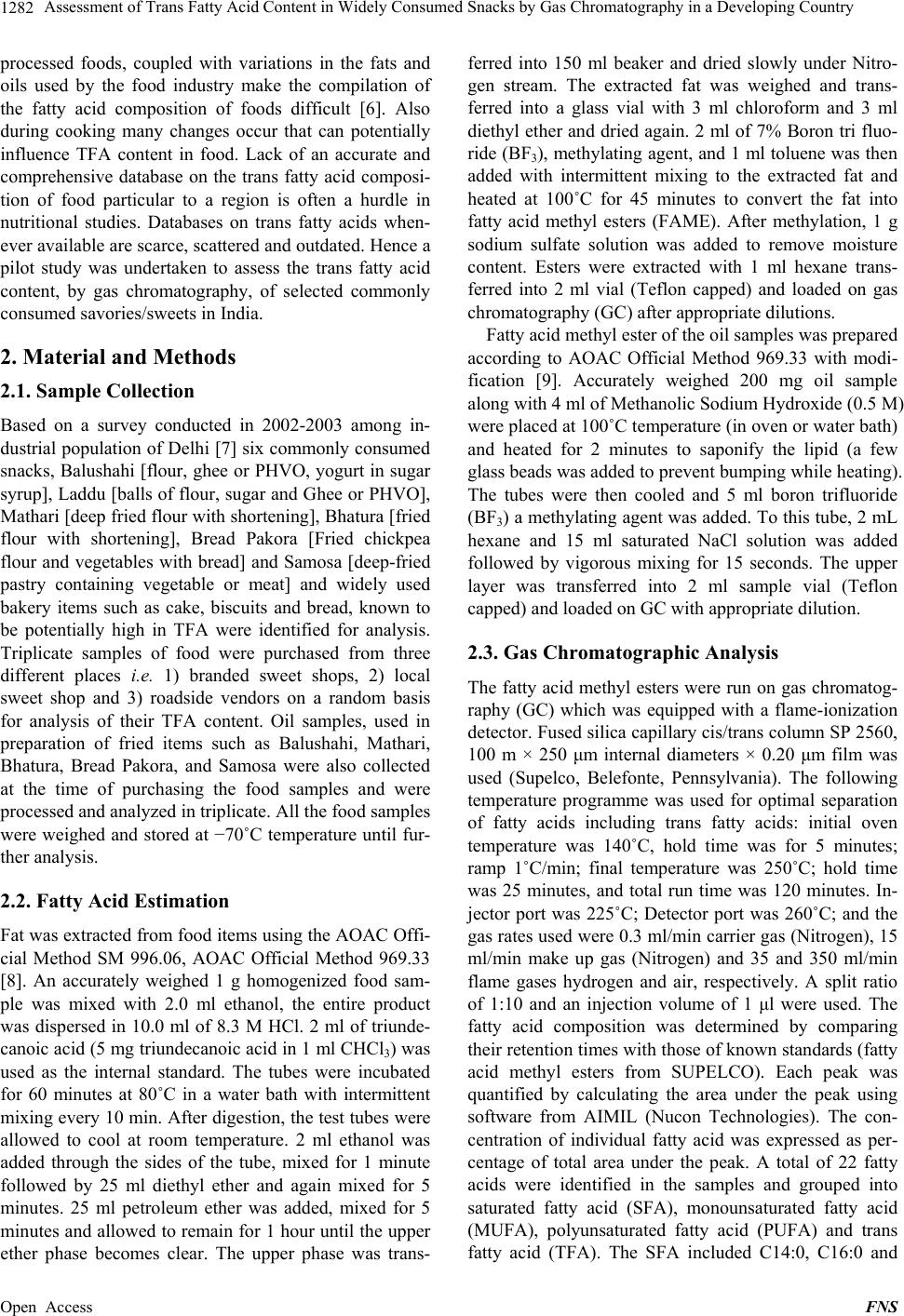
Assessment of Trans Fatty Acid Content in Widely Consumed Snacks by Gas Chromatography in a Developing Country
1282
processed foods, coupled with variations in the fats and
oils used by the food industry make the compilation of
the fatty acid composition of foods difficult [6]. Also
during cooking many changes occur that can potentially
influence TFA content in food. Lack of an accurate and
comprehensive database on the trans fatty acid composi-
tion of food particular to a region is often a hurdle in
nutritional studies. Databases on trans fatty acids when-
ever available are scarce, scattered and outdated. Hence a
pilot study was undertaken to assess the trans fatty acid
content, by gas chromatography, of selected commonly
consumed savories/sweets in India.
2. Material and Methods
2.1. Sample Collection
Based on a survey conducted in 2002-2003 among in-
dustrial population of Delhi [7] six commonly consumed
snacks, Balushahi [flour, ghee or PHVO, yogurt in sugar
syrup], Laddu [balls of flour, sugar and Ghee or PHVO],
Mathari [deep fried flour with shortening], Bhatura [fried
flour with shortening], Bread Pakora [Fried chickpea
flour and vegetables with bread] and Samosa [deep-fried
pastry containing vegetable or meat] and widely used
bakery items such as cake, biscuits and bread, known to
be potentially high in TFA were identified for analysis.
Triplicate samples of food were purchased from three
different places i.e. 1) branded sweet shops, 2) local
sweet shop and 3) roadside vendors on a random basis
for analysis of their TFA content. Oil samples, used in
preparation of fried items such as Balushahi, Mathari,
Bhatura, Bread Pakora, and Samosa were also collected
at the time of purchasing the food samples and were
processed and analyzed in triplicate. All the food samples
were weighed and stored at −70˚C temperature until fur-
ther analysis.
2.2. Fatty Acid Estimation
Fat was extracted from food items using the AOAC Offi-
cial Method SM 996.06, AOAC Official Method 969.33
[8]. An accurately weighed 1 g homogenized food sam-
ple was mixed with 2.0 ml ethanol, the entire product
was dispersed in 10.0 ml of 8.3 M HCl. 2 ml of triunde-
canoic acid (5 mg triundecanoic acid in 1 ml CHCl3) was
used as the internal standard. The tubes were incubated
for 60 minutes at 80˚C in a water bath with intermittent
mixing every 10 min. After digestion, the test tubes were
allowed to cool at room temperature. 2 ml ethanol was
added through the sides of the tube, mixed for 1 minute
followed by 25 ml diethyl ether and again mixed for 5
minutes. 25 ml petroleum ether was added, mixed for 5
minutes and allowed to remain for 1 hour until the upper
ether phase becomes clear. The upper phase was trans-
ferred into 150 ml beaker and dried slowly under Nitro-
gen stream. The extracted fat was weighed and trans-
ferred into a glass vial with 3 ml chloroform and 3 ml
diethyl ether and dried again. 2 ml of 7% Boron tri fluo-
ride (BF3), methylating agent, and 1 ml toluene was then
added with intermittent mixing to the extracted fat and
heated at 100˚C for 45 minutes to convert the fat into
fatty acid methyl esters (FAME). After methylation, 1 g
sodium sulfate solution was added to remove moisture
content. Esters were extracted with 1 ml hexane trans-
ferred into 2 ml vial (Teflon capped) and loaded on gas
chromatography (GC) after appropriate dilutions.
Fatty acid methyl ester of the oil samples was prepared
according to AOAC Official Method 969.33 with modi-
fication [9]. Accurately weighed 200 mg oil sample
along with 4 ml of Methanolic Sodium Hydroxide (0.5 M)
were placed at 100˚C temperature (in oven or water bath)
and heated for 2 minutes to saponify the lipid (a few
glass beads was added to prevent bumping while heating).
The tubes were then cooled and 5 ml boron trifluoride
(BF3) a methylating agent was added. To this tube, 2 mL
hexane and 15 ml saturated NaCl solution was added
followed by vigorous mixing for 15 seconds. The upper
layer was transferred into 2 ml sample vial (Teflon
capped) and loaded on GC with appropriate dilution.
2.3. Gas Chromatographic Analysis
The fatty acid methyl esters were run on gas chromatog-
raphy (GC) which was equipped with a flame-ionization
detector. Fused silica capillary cis/trans column SP 2560,
100 m × 250 μm internal diameters × 0.20 μm film was
used (Supelco, Belefonte, Pennsylvania). The following
temperature programme was used for optimal separation
of fatty acids including trans fatty acids: initial oven
temperature was 140˚C, hold time was for 5 minutes;
ramp 1˚C/min; final temperature was 250˚C; hold time
was 25 minutes, and total run time was 120 minutes. In-
jector port was 225˚C; Detector port was 260˚C; and the
gas rates used were 0.3 ml/min carrier gas (Nitrogen), 15
ml/min make up gas (Nitrogen) and 35 and 350 ml/min
flame gases hydrogen and air, respectively. A split ratio
of 1:10 and an injection volume of 1 μl were used. The
fatty acid composition was determined by comparing
their retention times with those of known standards (fatty
acid methyl esters from SUPELCO). Each peak was
quantified by calculating the area under the peak using
software from AIMIL (Nucon Technologies). The con-
centration of individual fatty acid was expressed as per-
centage of total area under the peak. A total of 22 fatty
acids were identified in the samples and grouped into
saturated fatty acid (SFA), monounsaturated fatty acid
(MUFA), polyunsaturated fatty acid (PUFA) and trans
fatty acid (TFA). The SFA included C14:0, C16:0 and
Open Access FNS